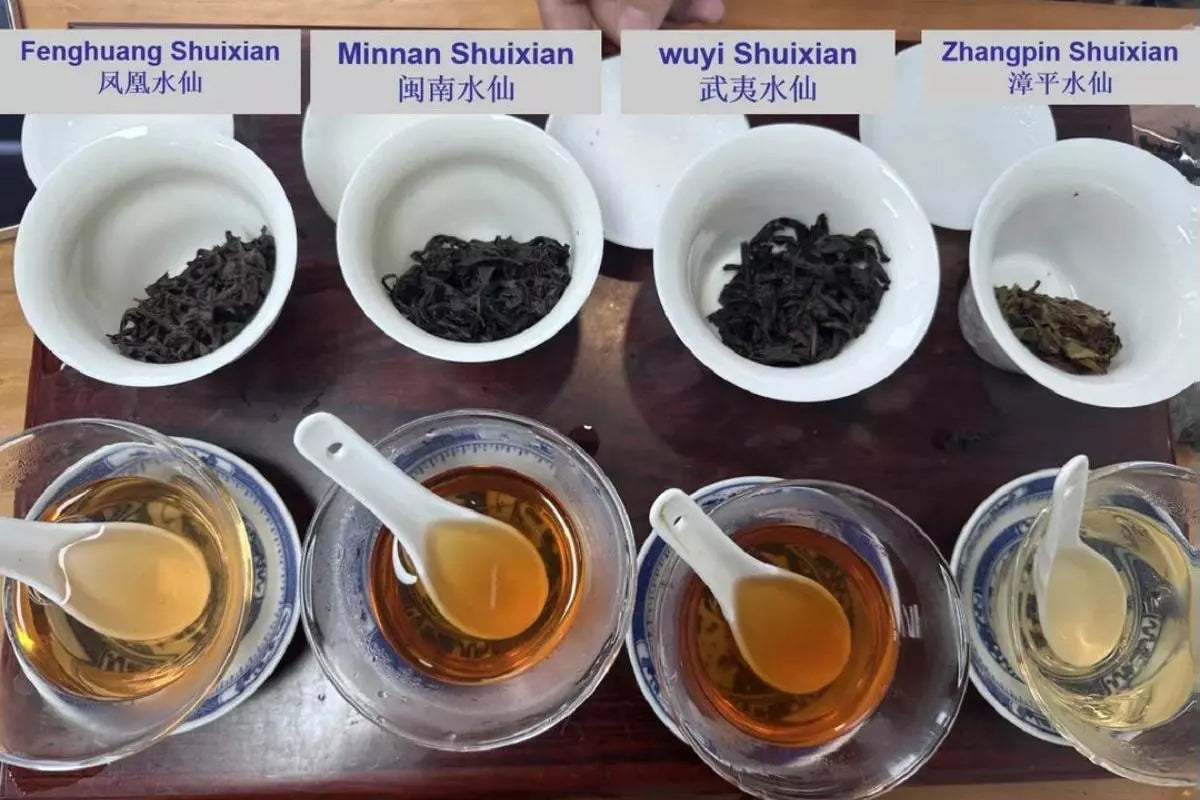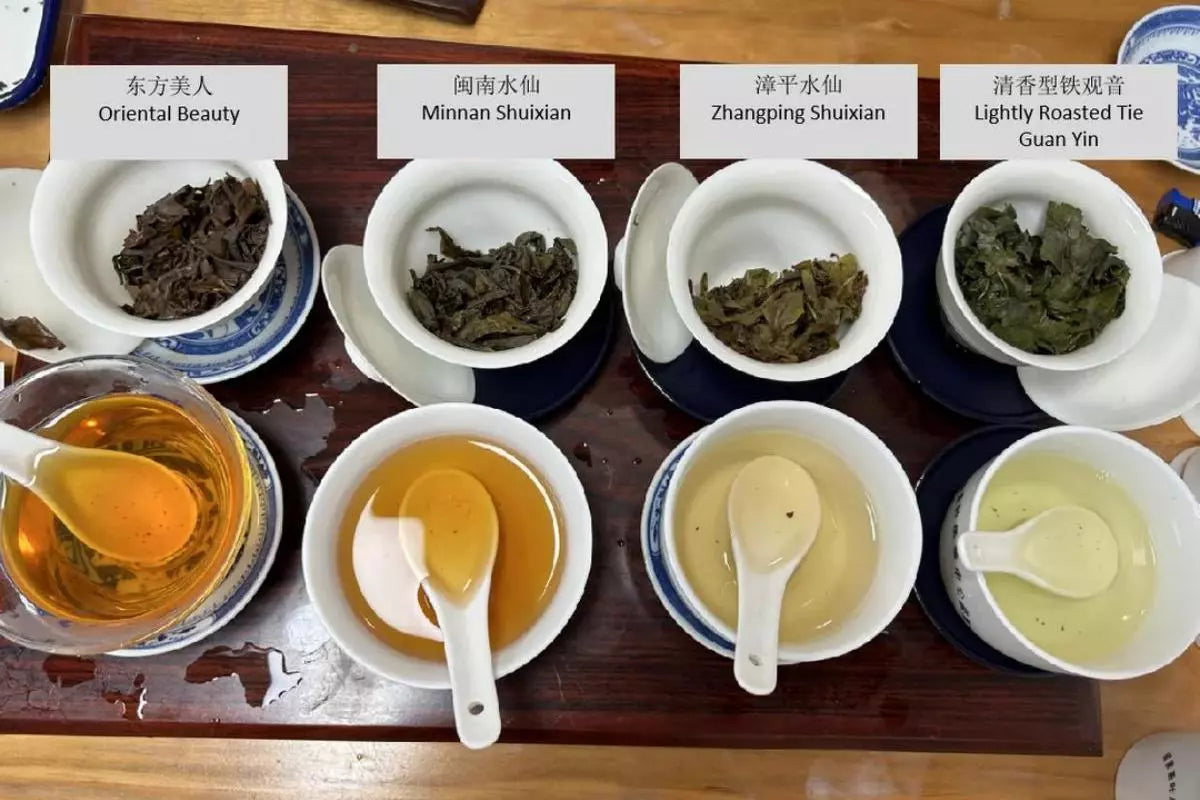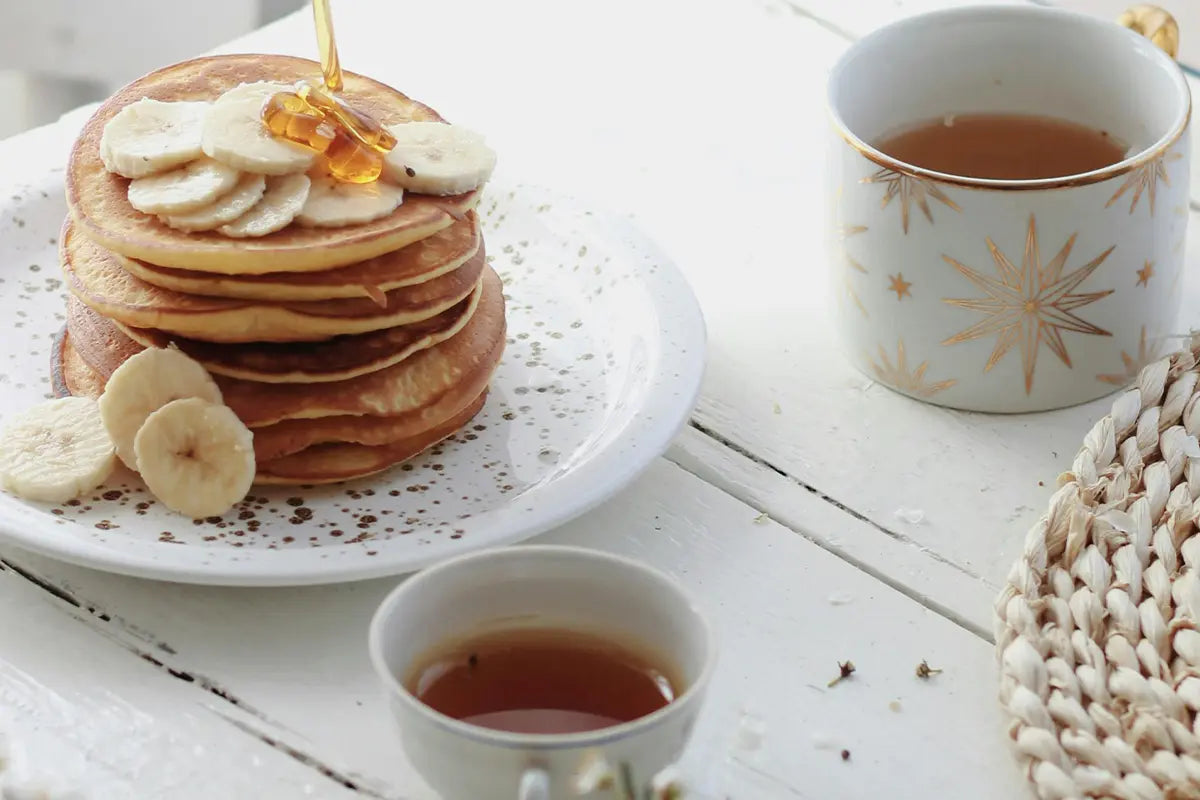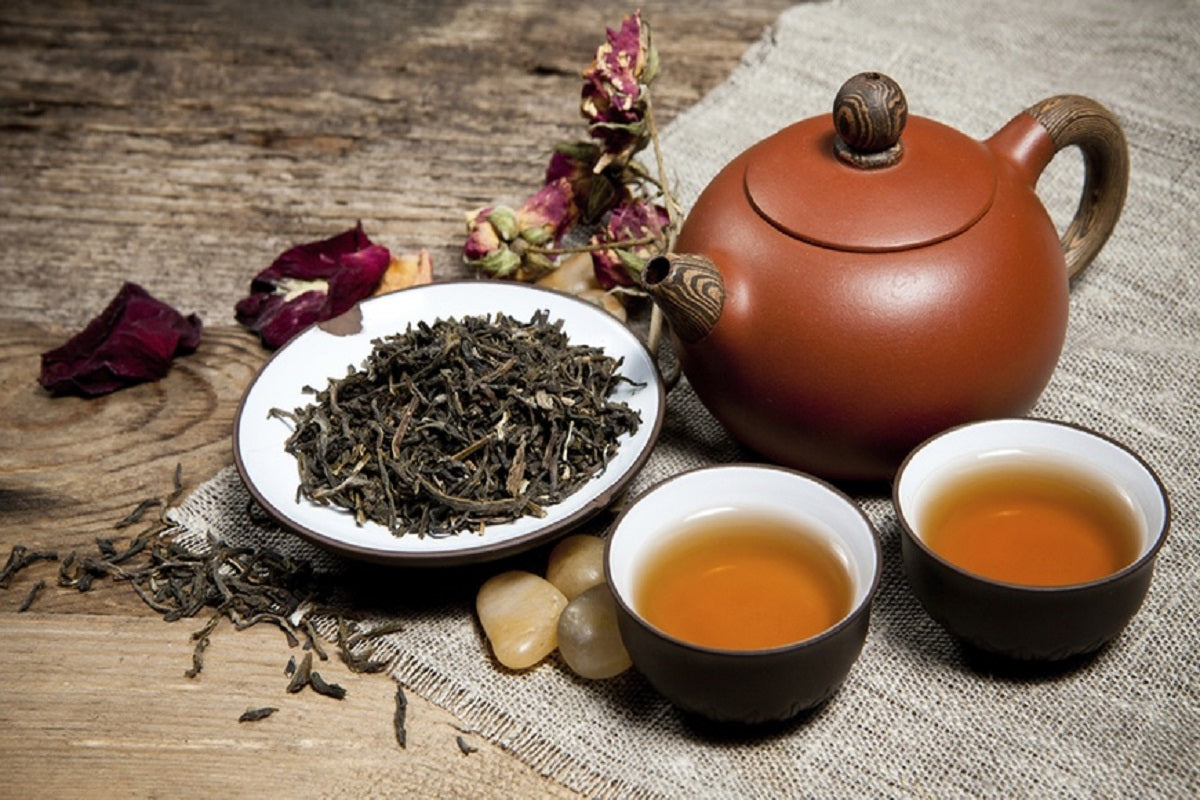Oolong tea is a traditional Chinese tea. It is known as semi-fermented tea, is referred to as the "Qing tea" among the six major tea categories. There's a wide variety of oolong teas, with some notable ones like Da Hong Pao, Tie Guan Yin, Dan Cong, Shui Xian, and Rou Gui. A cup of oolong tea offers a lingering fragrance and a delightful, sweet aftertaste, making it a beloved choice among tea enthusiasts.
As a deep lover to the world of loose leaf oolong tea, I've delved into various tea forums and absorbed insights from experienced connoisseurs. I've had the opportunity to taste different teas, either through my own purchases or shared by friends.
Firstly, let's get a general understanding of oolong tea:
Oolong Tea Classification:
Based on Origin:
① Northern Fujian Oolong (Da Hong Pao)
② Southern Fujian Oolong (Anxi Tie Guan Yin)
③ Guangdong Oolong (Phoenix Dan Cong)
④ Taiwanese Oolong (Dong Ding Oolong)
Based on Processing Method:
① Roasted Type (Northern Fujian and Guangdong Oolong Tea)
② Strong Aroma Type (Southern Fujian Oolong Tea)
③ Light Aroma Type (Southern Fujian Oolong Tea)
Based on Appearance:
① Strip Form (Phoenix Dan Cong)
② Semi-ball Form (Tie Guan Yin, Dong Ding Oolong)
③ Bundled Oolong Tea (Bajiao Ting Long Xu Tea)
④ Block Form (Narcissus Cake Tea)
Based on Fermentation Level:
① Lightly Fermented Tea (Light Aroma Type Tie Guan Yin)
② Moderately Fermented Tea (Tie Guan Yin, Wuyi Rock Tea, Phoenix Dan Cong, etc.)
③ Heavily Fermented Tea (Dongfang Meiren)
Tips:
>> Although Oolong Tea classification is diverse and intricate, the main classification is primarily based on categories 1 and 2.
>> In terms of the main characteristics of dry tea, Oolong Tea can be broadly divided into two major categories: roasted and unroasted.
Typical Characteristics of Oolong Tea:
Rich Aroma
Mellow and Sweet Taste, Enduring through Multiple Infusions
Leaves exhibit a certain level of maturity, giving the dry tea a relatively coarse appearance
There are many varieties of oolong tea, which can be divided into five main varieties such as Anxi Tieguanyin, Phoenix Narcissus, Dongding Oolong, Dahongpao and Oriental Beauty. Fortunately, I have tasted all of these. Here's a glimpse into the flavors of 5 best Chinese loose leaf oolong teas I've had the pleasure of trying, hopefully offering a reference for others:
● Tieguanyin —Anxi, Fujian
● Phoenix Dancong - Chaozhou, Guangdong
● Wuyi Rock Tea (Dahongpao) - Wuyi Mountain, Fujian
● Oriental Beauty—Taiwan
● Dongding Oolong – Taiwan
If you'd like to learn more about oolong tea, I suggest you refer to this blog post :Loose Leaf Oolong Tea Buying Guide. It contains comprehensive knowledge about Chinese oolong tea.
I have mentioned some very famous oolong teas above. Next, I will share 5 best Chinese oolong teas I tried:
Top 1: Anxi Tieguanyin
Tieguanyin is the pinnacle among oolong teas, boasting quality features of curled tea leaves, a heavy and uniform appearance, a sandy green color, and robust, round structures. Its leaves resemble dragonfly heads, frog legs, spirals, and more. Upon steeping, Tieguanyin reveals a stunning golden amber infusion with a natural fragrance akin to orchids. Its taste is sweet, fresh, and rich, leaving a lingering sweetness that persists on the lips and tongue. Known for enduring multiple infusions, it's often referred to as having "fragrance lingering after seven brews."
Read this article, get to konw health benefits of tieguanyin: The health benefits of tieguanyin tea
Growing Origin:
Anxi, located in the hilly region of southern Fujian.
History Origin:
Tea production in Anxi dates back to the late Tang Dynasty, was widely cultivated during the Song and Yuan periods, and flourished during the Ming and Qing dynasties.
Characteristics:
The tea exhibits thick, stout strips that are round and resemble dragonfly heads, heavy with hard twigs, neatly arranged bark at the twig's end, with most leaves curling towards the back, displaying a lustrous, dark green color (in modern processing, red edges have mostly been removed).
Liquor Color:
Clear and bright yellow
Taste:
Sipping delicately reveals a thick, sweet, and fresh tea soup with a subtle rotation at the base of the tongue. When slowly swallowed, it leaves a dense lingering sweetness with endless charm.
Appraisal: Tieguanyin vs. Motoyama tea
The stems of Motoyama tea are segmented, resembling bamboo poles. Due to processing, there might be a phenomenon where the flesh breaks while the skin remains intact. However, Tieguanyin breaks cleanly, exhibiting a remarkably even cross-section, resembling a cut made with a knife. Observing the particles, Tieguanyin tends to be larger and more robust compared to Motoyama tea, and after brewing, the Motoyama tea sediment isn't as thick as that of Tieguanyin.
(Explanation of Motoyama tea: For seasoned tea enthusiasts familiar with Tieguanyin, Motoyama tea isn't a new term, but recently, it's often viewed unfavorably. Its appearance and tea soup taste similar to Tieguanyin, leading many unscrupulous merchants to pass off Motoyama tea as Tieguanyin, deceiving consumers. This has led to it being mockingly referred to as "Tieguanyin's younger sibling tea." If you're concerned about purchasing Motoyama tea, I recommend buying authentic Tieguanyin directly from its place of origin from iTeaworld, a brand you can trust.)
Top 2: Fenghuang Dancong
Fenghuang Dancong, also known as "Guangdong Narcissus," is a type of strip tea and a renowned historical tea. It originates from superior individual plants of the Fenghuang Narcissus species. It is named 'Dancong' due to being harvested and processed individually, while "Fenghuang Dancong" refers collectively to various exceptional individual plants. It possesses unique qualities of being "beautiful in form, emerald in color, fragrant in aroma, and sweet in taste." Fenghuang Dancong is also known as "perfume in tea," boasting a total of 79 natural fragrance profiles. Among these, the ten most famous fragrances include: Yellow Gardenia, Honey Orchid, Magnolia, Night-Blooming Jasmine, Almond, Gardenia, Osmanthus, Ginger Flower, Jasmine, and Cinnamon.
Growing Origin:
Fenghuang Mountain, Chao'an County, Guangdong Province
Historical Origin:
Dating back to the end of the Southern Song Dynasty, with a history of over 900 years.
Characteristics:
Thick and robust strip-like appearance, uniform and upright, with a yellow-brown color and glossy surface, often bearing red cinnabar dots. After brewing, it emits a long-lasting clear fragrance, notably a distinct natural orchid aroma. The leaf edges exhibit crimson red, while the leaf body is bright yellow, known for its unique mountainous character with green leaves and red edges.
Liquor Color:
Clear and bright yellow(specifically referring to Honey Orchid Fragrance )
Taste:
Rich, mellow, refreshing, and leaves a lingering sweetness and moisture in the throat.
Appraisal:
I highly recommend the Honey Orchid tea leaves among the top ten fragrances of Fenghuang Dancong. Its taste features a noticeable "sweet potato" sweetness, accompanied by intense and lasting Gardenia and honey fragrance. If you ask for my recommendation, I suggest trying this particular variety, Fenghuang Dancong Oolong Tea (Mi Lan Xiang), available from iTeaworld.
Top 3: Da Hong Pao
In the millennium-long tea culture of China, Wuyi Rock Tea undoubtedly holds the highest prestige. Among them, Da Hong Pao from Wuyi is hailed as one of the best, earning titles such as the "Top Scholar in Tea" and "King of Wuyi Tea." Its name originates from the vibrant red appearance of the entire tea tree when the early spring tea buds sprout, resembling a red robe when viewed from a distance, hence named "Da Hong Pao."
If you want to know more comprehensive information about da hong pao, read these articles:
All about da hong pao: types, origins, and how to Brew Health benefits of dahongpao tea
Growing Origin:
Wuyi Mountain, Fujian Province
Historical Origin:
Legend has it that the name originated during the Ming Dynasty, with a history of over 400 years.
Characteristics:
The dry tea presents a brownish-black color, tightly knotted strips with a relatively moist appearance. It emits a faint woody fragrance, reminiscent of oily nuts. The wet leaves showcase a moist brownish-black color, slightly wrinkled, with uniformly sized leaves emitting a light botanical scent.
Liquor Color:
Bright orange-yellow
Taste:
Soft and mellow upon entry, sweet and thick. It boasts a rich fragrance with a high and lasting orchid aroma, exhibiting a prominent rocky essence.
Appraisal:
Da Hong Pao endures multiple infusions; I brewed it seven or eight times and the fragrance persisted. To savor Da Hong Pao fully, one must follow the ritual of Gongfu tea, employing a small pot and small cups, sipping slowly to truly experience the Zen-like charm of Wuyi Rock Tea's pinnacle.
Try the oolong tea sampler of 4 best oolong tea. >>>
Top 4: Oriental Beauty
This unique tea hails exclusively from Taiwan, standing out as one of the most heavily fermented among oolong teas, ranging from 60% to an astonishing 75-85% fermentation. The name supposedly originates from British tea merchants presenting this tea to Queen Victoria. When the tea leaves swirled beautifully in a glass pot, she was so enchanted that she dubbed it "Oriental Beauty Tea."
Growing Origin:
Taiwan
Historical Origin:
19th century
Characteristics:
Neat and uniform, featuring one bud with two leaves, exhibiting a slight curl resembling a connected bouquet, akin to flowers. The leaves reveal a soft, glossy, and lustrous underside.
Liquor Color:
Bright and vibrant, with an amber tea hue
Taste:
The taste is rounded, full-bodied, rich, soft, sweet, and smooth, with a robust and pure aroma that leaves a lingering, refreshing, and long-lasting aftertaste.
Appraisal:
As Oriental Beauty is the most heavily fermented among semi-fermented teas, first-time drinkers might find its taste strikingly similar to black tea, which is quite normal. Compared to other oolong teas, Oriental Beauty starts sweet on the palate, lacking bitterness or astringency, making it suitable for beginners. If you're intrigued by Oriental Beauty tea, consider watching the episode in the documentary series "Tea in China" that explores its taste profile. Additionally, tea master Xu Yaoliang thoroughly discusses the tea-making process in the documentary.
Top 5: Dong Ding Oolong
Taiwanese Dong Ding Oolong, commonly known as Dong Ding Tea, is a renowned semi-fermented tea cultivated in Taiwan and named after the Dong Ding Mountain. The primary raw material for Dong Ding Oolong comes from the Qing Xin Oolong tea trees on Dong Ding Mountain. The region boasts an average annual temperature of 22°C, abundant water, lush vegetation, and is shrouded in mist and clouds year-round—ideal conditions for tea tree growth. However, due to the steep terrain, harvesting is challenging, resulting in limited and exceptionally precious production.
Growing Origin:
Lugu Township, Taiwan
Historical Origin:
With a long history, legend has it that in the fifth year of the Xianfeng era in the Qing Dynasty (1855), Lin Fengchi, a villager from Lugu Township, Nantou, brought back Wuyi Oolong tea seedlings from Fujian, gradually developing into today's Dong Ding Tea Garden on Dong Ding Mountain.
Characteristics:
Tightly rolled granules, forming semi-spherical curls with a glossy dark green color.
Taste:
Rich, mellow, and sweet with intense mountainous fragrance, exhibiting a persistent floral and fruity aroma.
Liquor Color:
Honey-yellow, clear, and bright
Appraisal:
Upon careful savoring, a delicate balance of sweetness and acidity fills the palate. The slight fermentation of the tea leaves and the sweetness from light roasting complement each other, creating an exquisite harmony. Additionally, the natural milky fragrance imparts a velvety smoothness akin to milk tea.
Common matching formulas for oolong tea:
【Osmanthus + Oolong Tea】: Lung-nourishing and Moisturizing
【Longan + Oolong Tea】: Blood Tonifying and Health-preserving
【Lemon + Oolong Tea】: Heat-clearing and Digestive Aid
【Peach + Oolong Tea】: Beauty-enhancing and Nourishing
【Sweet Pear + Oolong Tea】: Cough-relieving and Lung-moistening
【Lychee + Oolong Tea】: Detoxifying and Beauty-enhancing
【Kumquat + Preserved Plum + Oolong Tea】: Digestive Aid and Cough-relieving
【Grape + Waxberry + Lemon + Oolong Tea】: Heat-clearing and Appetite-stimulating
Try these matching formulas with iTeaworld's premium loose leaf tea.
How to brew oolong teas?
Tea Set Selection:
Purple Clay Teapot and White Porcelain Gaiwan are commonly used utensils for brewing Oolong tea. The brewing vessel should have a lid. For brewing and tasting Oolong tea, it's preferable to use small cups or bowls as "small vessels keep the aroma intact without dissipating, allowing for a more focused taste."
Tea to Water Ratio:
Tea-to-water ratio: 1:20-30
5 grams of tea + 100-150 milliliters of water
You can adjust tea quantity based on preferred taste.
Water Temperature Consideration:
Oolong tea, being relatively mature in raw materials, contains a variety of high boiling point aromatic substances, such as floral and fruity scents. Therefore, it's recommended to use freshly boiled water, close to 100°C for brewing Oolong tea. Higher water temperature leads to better aroma extraction, higher tea juice yield, and a more concentrated flavor, accentuating the unique charm of Oolong tea. If the water temperature is low, the aroma and taste might appear weak.
Note: Warming the teapot and cups before brewing and pouring hot water during brewing are all methods to increase temperature and enhance the tea's fragrance and characteristics.
Brewing Frequencies:
● Lightly oxidized Oolong teas (such as TieGuanYin):
First infusion for about 40 seconds, the second infusion for 30 seconds, then increase steeping time by 15 seconds for subsequent infusions.
● Heavily oxidized Oolong teas (such as Da Hong Pao):
The first brew can be made immediately.
After soaking for 10 seconds, the soup will be ready.
Extend each time by 10 seconds in the future.
Key points for brewing oolong tea: Make use of strengths and avoid weaknesses!
Utilize strengths: High brewing stimulates aroma, high temperature and low pouring reduce aroma volatilization, showing the aroma of oolong tea.
Avoid shortcomings: Do not pour water against the tea leaves. Instead, pour water along the wall of the container to avoid bitterness.
What are the health benefits of drinking oolong tea regularly?
【Weight Loss】
The tannic acid in green tea has a close connection with fat metabolism, effectively aiding in weight loss and functioning as a slimming tea.
【Activation of Autonomic Nervous System】
Certain substances in Oolong Tea can effectively enhance the activity of the autonomic and parasympathetic nervous systems, inducing a sense of mental relaxation and overall comfort.
【Oil Elimination】
Combining Oolong Tea with oily foods not only increases satiety but also helps eliminate greasiness, imparting a refreshing tea aroma, promoting a more comfortable and healthy eating experience.
【Cholesterol Reduction】
Active compounds in Oolong Tea can dissolve fats effectively. Moreover, by enhancing energy metabolism, it can also inhibit the rise of cholesterol in the body, making it a healthy tea beverage.
【Cavity Prevention】
The polyphenols in green tea can inhibit plaque-forming enzymes, preventing the occurrence of plaque and cavities when consumed after meals.
【Anti-Aging】
Oolong Tea contains various active substances, including one that significantly boosts SOD enzyme activity, which plays a significant role in delaying aging and maintaining skin health.
Taboo Groups: Who can’t drink oolong tea?
- Avoid drinking oolong tea on an empty stomach.
- Avoid consuming oolong tea before bedtime.
- Do not drink cooled-down oolong tea.
- Oolong tea is not suitable for individuals with anemia.
- Oolong tea is not recommended for those suffering from constipation.
- Women during their menstrual period should avoid drinking oolong tea.
Suggestion
No matter which kind of oolong tea you like, I recommend you to try these five best oolong teas, you won't regret it. If you don’t know where to buy the best Chinese loose leaf oolong tea, I suggest you check out the loose leaf tea brand iTeaworld, which has these 5 kinds of tea. You can try their oolong tea sampler first. By purchasing this tea sampler, you can taste 4 different famous loose leaf oolong teas at one time. Of course, if you want to purchase a certain type of oolong tea individually, you can also find it on the website.






















